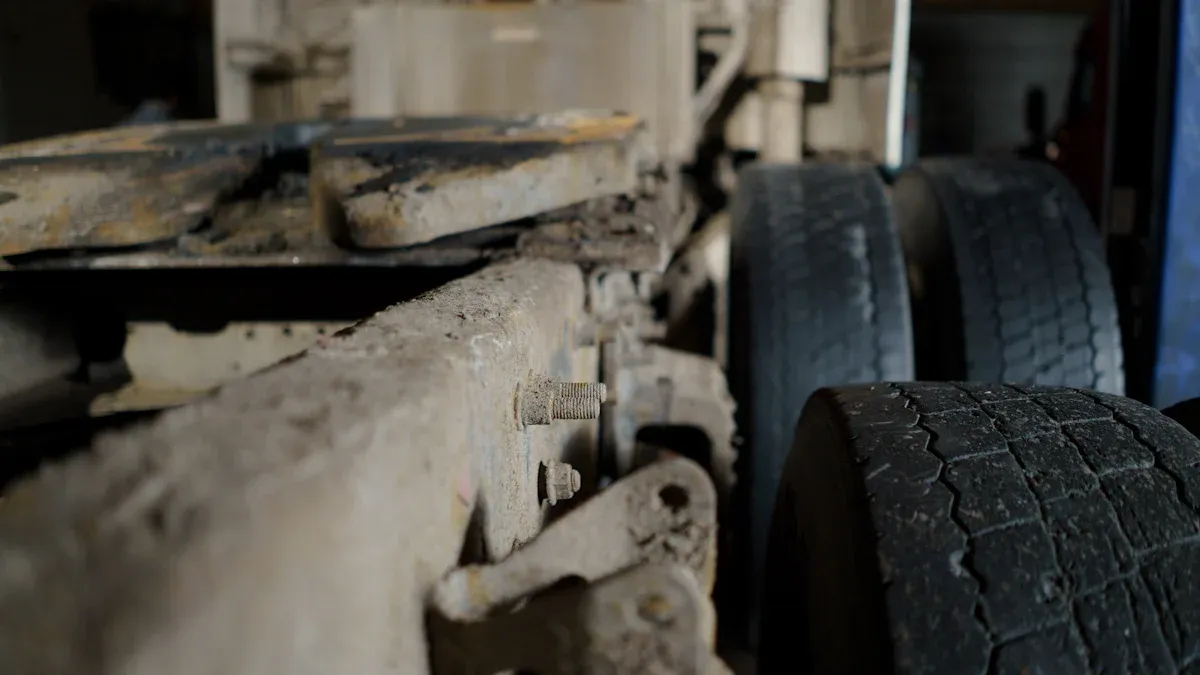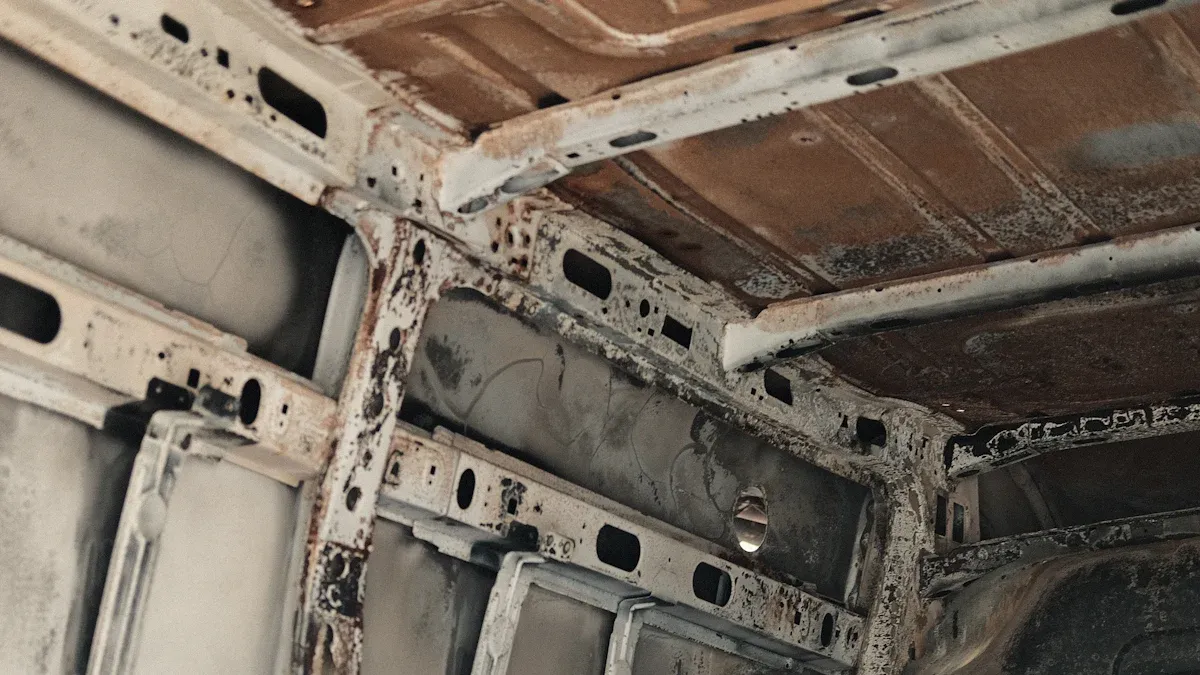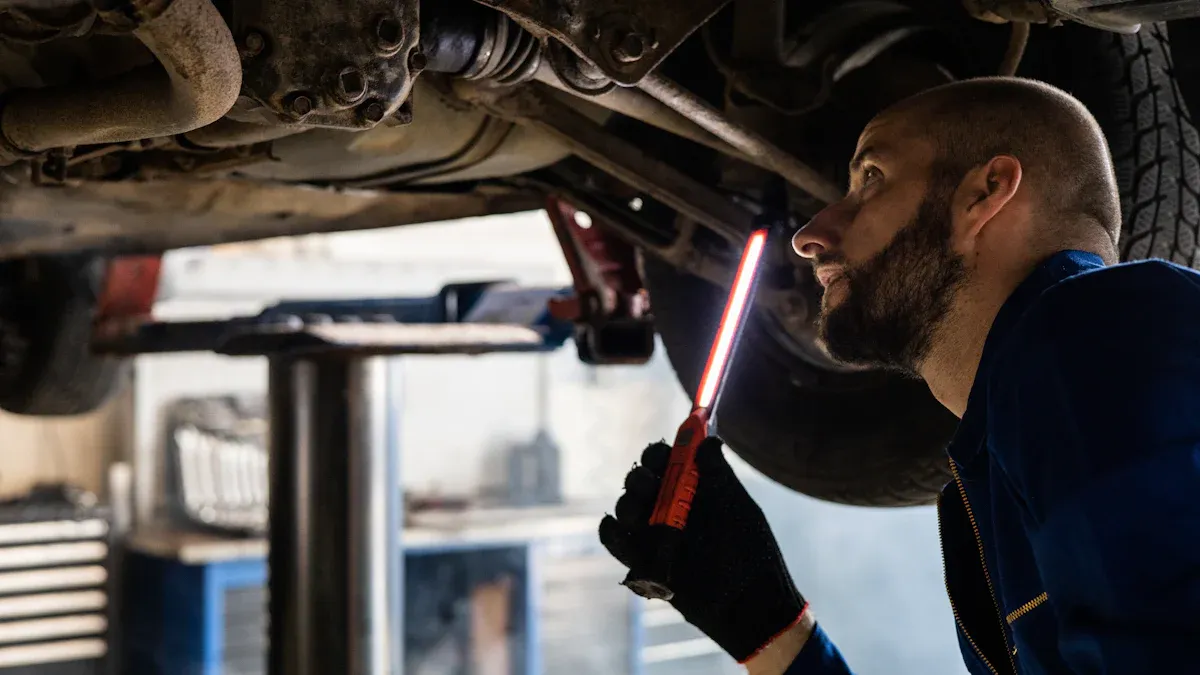
Truck chassis parts rely on materials like steel, aluminum, and magnesium. Each material offers unique advantages. Steel provides exceptional strength, aluminum reduces weight, and magnesium boosts efficiency. Choosing the right material ensures your truck performs better, stays safe, and lasts longer. These materials balance durability, weight, and cost to meet diverse needs.
Key Takeaways
- Steel is very strong and lasts a long time. It carries heavy loads and works well in tough conditions, keeping trucks safe and durable.
- Aluminum is lighter, helping trucks use less fuel and drive better. It does not rust easily, so it works well for many truck parts.
- Magnesium is the lightest material, making trucks more efficient. It is good for small parts but cannot hold heavy loads like steel or aluminum.
Common Truck Chassis Parts and Their Materials

Steel in Truck Chassis
Steel is one of the most common materials used in truck chassis parts. It offers excellent strength and durability, making it ideal for handling heavy loads. You’ll find steel in critical components like the frame rails and cross members. These parts need to withstand high stress and resist bending or breaking. Steel also performs well in extreme conditions, such as cold weather or rough terrain. Its ability to absorb impact makes it a reliable choice for safety.
Aluminum in Truck Chassis
Aluminum is another material often used in truck chassis parts. It is much lighter than steel, which helps reduce the overall weight of the truck. This weight reduction improves fuel efficiency and makes the vehicle easier to handle. Aluminum is commonly used in parts like brackets, panels, and even some frame sections. Despite being lightweight, aluminum is strong and resistant to corrosion. This makes it a great option for trucks that operate in wet or salty environments.
Magnesium in Truck Chassis
Magnesium is a newer material in the world of truck chassis parts. It is even lighter than aluminum, which makes it perfect for reducing weight further. You’ll often see magnesium in smaller components or areas where weight savings are critical. While it is not as strong as steel, magnesium offers good strength-to-weight ratio. It also helps improve fuel efficiency and reduces emissions, making it an eco-friendly choice.
Why These Materials Are Used in Truck Chassis
Strength and Durability
When it comes to truck chassis parts, strength and durability are essential. Steel is often chosen because it can handle heavy loads without bending or breaking. This makes it perfect for trucks that carry large cargo or travel on rough roads. Aluminum also offers good durability while resisting rust, which helps extend the life of your truck. Magnesium, though lighter, provides a decent balance of strength and flexibility for smaller components. These materials ensure your truck can withstand daily wear and tear while keeping you safe on the road.
Weight Reduction and Fuel Efficiency
Reducing weight is crucial for improving fuel efficiency. Aluminum and magnesium are lighter than steel, making them ideal for cutting down the overall weight of your truck. A lighter truck uses less fuel, which saves you money and reduces emissions. Aluminum is commonly used in panels and brackets to achieve this balance. Magnesium, being even lighter, is used in specific areas where weight savings are critical. By using these materials, manufacturers help you get better mileage without sacrificing performance.
Cost and Manufacturing Feasibility
The cost of materials plays a big role in truck design. Steel is affordable and easy to work with, which is why it’s widely used in truck chassis parts. Aluminum costs more but offers benefits like corrosion resistance and weight reduction. Magnesium, while lightweight, is more expensive and harder to manufacture. Manufacturers choose materials based on how they balance cost, performance, and ease of production. This ensures you get a truck that’s both reliable and cost-effective.
Comparing Truck Chassis Materials

Weight and Load Capacity
Weight plays a significant role in how a truck performs. Steel, being heavier, provides excellent load capacity and stability. It works well for trucks that need to carry heavy cargo. Aluminum, on the other hand, is much lighter. This makes it ideal for improving fuel efficiency while still handling moderate loads. Magnesium, the lightest of the three, is best for smaller components where weight savings are critical. However, it may not support as much weight as steel or aluminum. Choosing the right material depends on how much weight your truck needs to carry and how important fuel efficiency is to you.
Cost and Longevity
Steel is the most affordable material for truck chassis parts. It lasts a long time and resists wear and tear, making it a cost-effective choice. Aluminum costs more but offers better resistance to rust, which can extend the lifespan of your truck. Magnesium, while lightweight, is the most expensive and less durable. If you want a balance between cost and longevity, steel or aluminum might be the better option.
Safety and Crashworthiness
Safety is a top priority in truck design. Steel excels in crashworthiness because it absorbs impact well. This helps protect you and your cargo during accidents. Aluminum also performs well in crashes but may not be as strong as steel. Magnesium, while lightweight, is less effective in absorbing impact. For maximum safety, steel remains the most reliable option.
Environmental Impact and Recyclability
Recycling plays a big role in reducing environmental impact. Steel and aluminum are highly recyclable, making them eco-friendly choices. Aluminum, in particular, requires less energy to recycle compared to producing new material. Magnesium is recyclable too, but its production process can have a higher environmental footprint. If sustainability matters to you, steel and aluminum are excellent options.
Steel, aluminum, and magnesium each bring unique advantages to truck chassis design. Steel offers strength, aluminum reduces weight, and magnesium improves efficiency.
Your choice depends on priorities like cost, safety, and sustainability. Selecting the right material ensures better performance, longer lifespan, and lower environmental impact. Choose wisely to optimize your truck’s potential.
FAQ
What is the most durable material for truck chassis parts?
Steel is the most durable material. It handles heavy loads, resists wear, and performs well in extreme conditions, making it ideal for long-lasting truck chassis parts.
Why is aluminum used in truck chassis parts?
Aluminum reduces weight, improves fuel efficiency, and resists corrosion. These properties make it a great choice for brackets, panels, and other lightweight truck chassis parts.
Can magnesium replace steel in truck chassis parts?
Magnesium can replace steel in smaller components. It is lightweight and efficient but lacks the strength needed for larger, high-stress truck chassis parts.
Post time: Apr-11-2025

